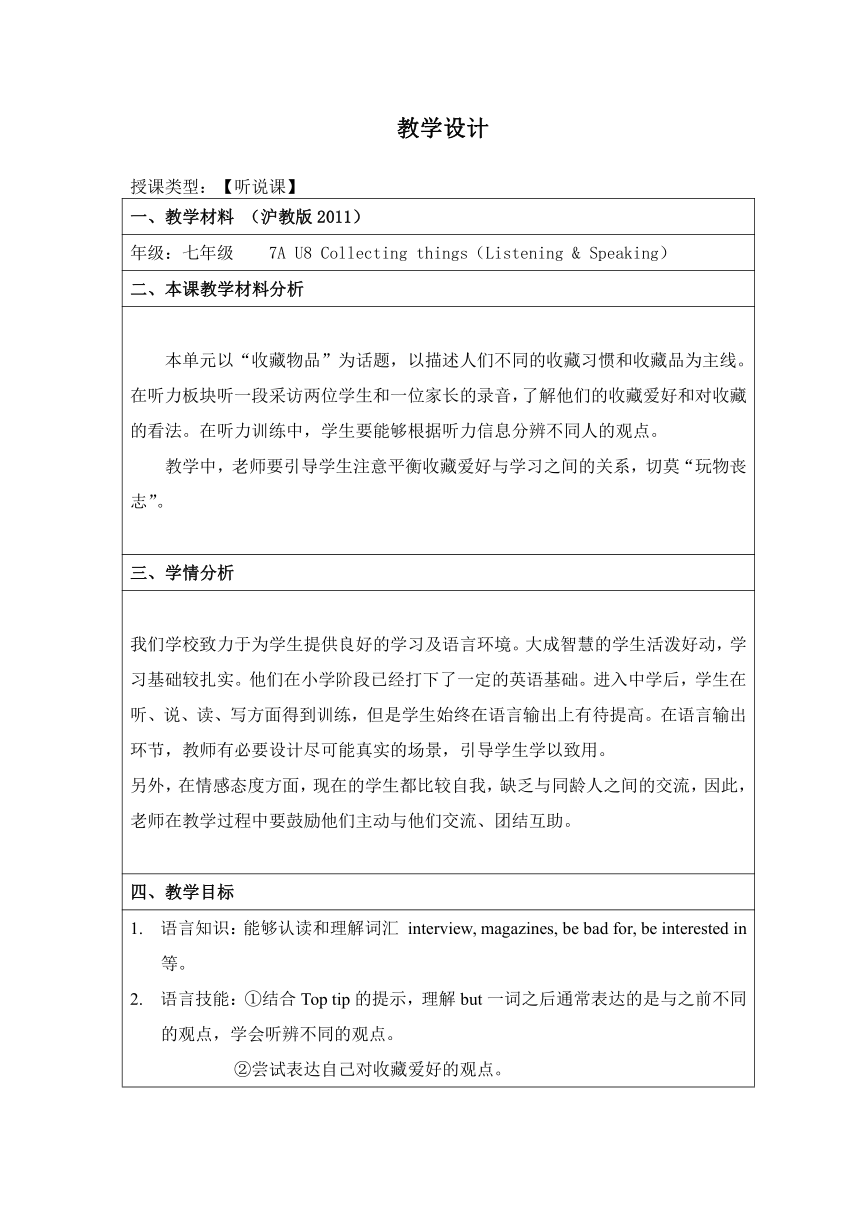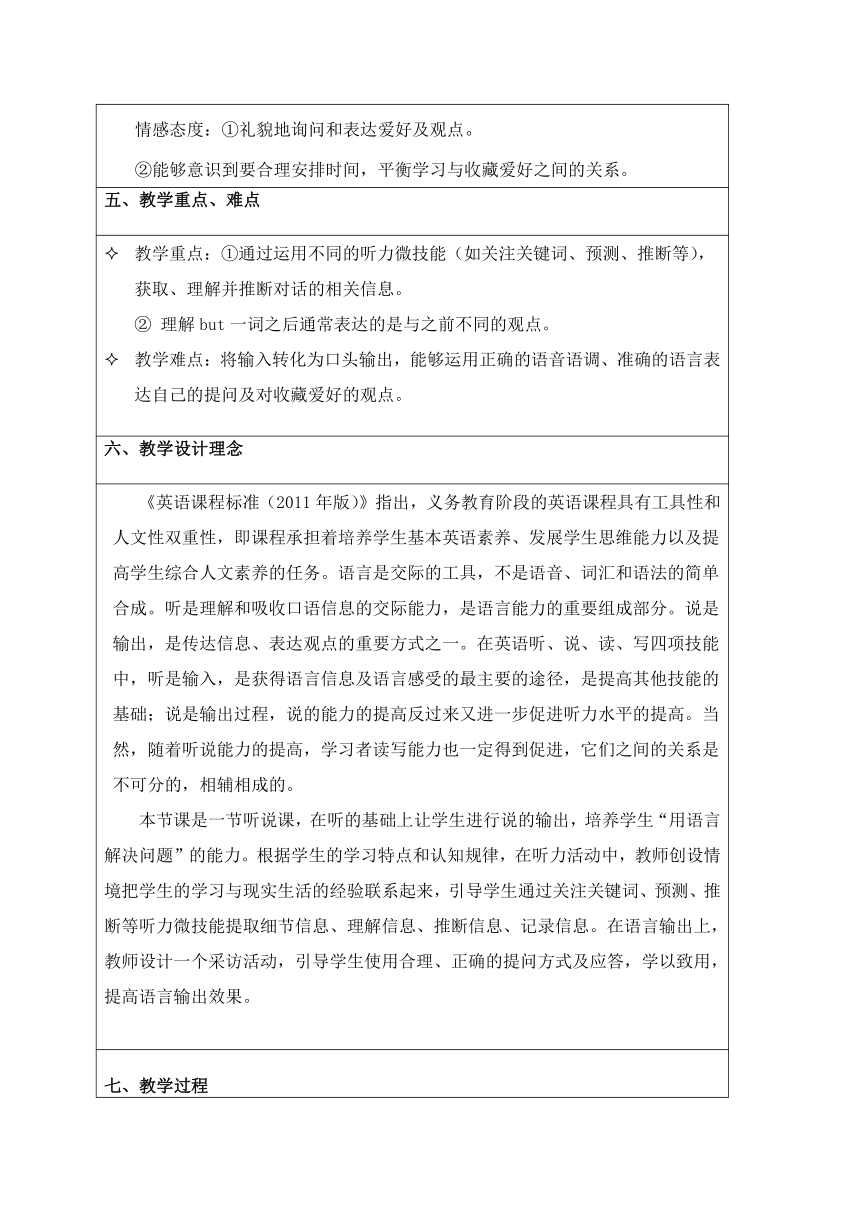牛津深圳版七年级上册Module 4 Fun time Unit 8 Collecting things(Listening & Speaking) 教学设计
文档属性
| 名称 | 牛津深圳版七年级上册Module 4 Fun time Unit 8 Collecting things(Listening & Speaking) 教学设计 |  | |
| 格式 | doc | ||
| 文件大小 | 184.0KB | ||
| 资源类型 | 教案 | ||
| 版本资源 | 牛津深圳版 | ||
| 科目 | 英语 | ||
| 更新时间 | 2022-09-29 20:27:07 | ||
图片预览


文档简介
教学设计
授课类型:【听说课】
一、教学材料 (沪教版2011)
年级:七年级 7A U8 Collecting things(Listening & Speaking)
二、本课教学材料分析
本单元以“收藏物品”为话题,以描述人们不同的收藏习惯和收藏品为主线。在听力板块听一段采访两位学生和一位家长的录音,了解他们的收藏爱好和对收藏的看法。在听力训练中,学生要能够根据听力信息分辨不同人的观点。教学中,老师要引导学生注意平衡收藏爱好与学习之间的关系,切莫“玩物丧志”。
三、学情分析
我们学校致力于为学生提供良好的学习及语言环境。大成智慧的学生活泼好动,学习基础较扎实。他们在小学阶段已经打下了一定的英语基础。进入中学后,学生在听、说、读、写方面得到训练,但是学生始终在语言输出上有待提高。在语言输出环节,教师有必要设计尽可能真实的场景,引导学生学以致用。另外,在情感态度方面,现在的学生都比较自我,缺乏与同龄人之间的交流,因此,老师在教学过程中要鼓励他们主动与他们交流、团结互助。
四、教学目标
语言知识:能够认读和理解词汇 interview, magazines, be bad for, be interested in 等。语言技能:①结合Top tip的提示,理解but一词之后通常表达的是与之前不同的观点,学会听辨不同的观点。②尝试表达自己对收藏爱好的观点。情感态度:①礼貌地询问和表达爱好及观点。②能够意识到要合理安排时间,平衡学习与收藏爱好之间的关系。
五、教学重点、难点
教学重点:①通过运用不同的听力微技能(如关注关键词、预测、推断等),获取、理解并推断对话的相关信息。② 理解but一词之后通常表达的是与之前不同的观点。教学难点:将输入转化为口头输出,能够运用正确的语音语调、准确的语言表达自己的提问及对收藏爱好的观点。
六、教学设计理念
《英语课程标准(2011年版)》指出,义务教育阶段的英语课程具有工具性和人文性双重性,即课程承担着培养学生基本英语素养、发展学生思维能力以及提高学生综合人文素养的任务。语言是交际的工具,不是语音、词汇和语法的简单合成。听是理解和吸收口语信息的交际能力,是语言能力的重要组成部分。说是输出,是传达信息、表达观点的重要方式之一。在英语听、说、读、写四项技能中,听是输入,是获得语言信息及语言感受的最主要的途径,是提高其他技能的基础;说是输出过程,说的能力的提高反过来又进一步促进听力水平的提高。当然,随着听说能力的提高,学习者读写能力也一定得到促进,它们之间的关系是不可分的,相辅相成的。本节课是一节听说课,在听的基础上让学生进行说的输出,培养学生“用语言解决问题”的能力。根据学生的学习特点和认知规律,在听力活动中,教师创设情境把学生的学习与现实生活的经验联系起来,引导学生通过关注关键词、预测、推断等听力微技能提取细节信息、理解信息、推断信息、记录信息。在语言输出上,教师设计一个采访活动,引导学生使用合理、正确的提问方式及应答,学以致用,提高语言输出效果。
七、教学过程
Step One Leading-in Greet Ss and get them to learn about the plan for today.Get Ss to take part in Memory Challenge. Purpose: Help Ss to have a broad picture of what we are going to do in this class.Arouse Ss’ interest in this lesson and activate Ss’ background information of personal collections.Step Two ListeningListening APredict who says the sentences and complete the notesListen and check the answers.Ss are asked to answer the questions in a whole sentence. Understand the words after “but”.Listening BPredict and complete the table. Listen and check the answers.Ss are asked to pay attention to Plural form; Capital letter; NumberPurpose:Help train Ss’ listening skills.Tips for listening(1) Read the information quickly. (2) Try to predict the answers.(3) Pay attention to the words after “but”.2. Prepare Ss for speakingStep Three SpeakingInterview two people about their collection(s) with the help of an example.Follow the example to give a reportPurpose:The examples help arouse Ss’ interest and get them to play an active role in speaking English.The interview helps improve Ss’ oral English and their cooperative ability.Step Four SummaryWhat have learnt and what do you think of the relationship between “study” and “collecting things” Purpose:Emotioal educationSs are asked to think about the relationship betwwen study and collecting things. They will be able to balance the time between them.Step Five Self-assessment Write an article about your collection(s).
Collections
授课类型:【听说课】
一、教学材料 (沪教版2011)
年级:七年级 7A U8 Collecting things(Listening & Speaking)
二、本课教学材料分析
本单元以“收藏物品”为话题,以描述人们不同的收藏习惯和收藏品为主线。在听力板块听一段采访两位学生和一位家长的录音,了解他们的收藏爱好和对收藏的看法。在听力训练中,学生要能够根据听力信息分辨不同人的观点。教学中,老师要引导学生注意平衡收藏爱好与学习之间的关系,切莫“玩物丧志”。
三、学情分析
我们学校致力于为学生提供良好的学习及语言环境。大成智慧的学生活泼好动,学习基础较扎实。他们在小学阶段已经打下了一定的英语基础。进入中学后,学生在听、说、读、写方面得到训练,但是学生始终在语言输出上有待提高。在语言输出环节,教师有必要设计尽可能真实的场景,引导学生学以致用。另外,在情感态度方面,现在的学生都比较自我,缺乏与同龄人之间的交流,因此,老师在教学过程中要鼓励他们主动与他们交流、团结互助。
四、教学目标
语言知识:能够认读和理解词汇 interview, magazines, be bad for, be interested in 等。语言技能:①结合Top tip的提示,理解but一词之后通常表达的是与之前不同的观点,学会听辨不同的观点。②尝试表达自己对收藏爱好的观点。情感态度:①礼貌地询问和表达爱好及观点。②能够意识到要合理安排时间,平衡学习与收藏爱好之间的关系。
五、教学重点、难点
教学重点:①通过运用不同的听力微技能(如关注关键词、预测、推断等),获取、理解并推断对话的相关信息。② 理解but一词之后通常表达的是与之前不同的观点。教学难点:将输入转化为口头输出,能够运用正确的语音语调、准确的语言表达自己的提问及对收藏爱好的观点。
六、教学设计理念
《英语课程标准(2011年版)》指出,义务教育阶段的英语课程具有工具性和人文性双重性,即课程承担着培养学生基本英语素养、发展学生思维能力以及提高学生综合人文素养的任务。语言是交际的工具,不是语音、词汇和语法的简单合成。听是理解和吸收口语信息的交际能力,是语言能力的重要组成部分。说是输出,是传达信息、表达观点的重要方式之一。在英语听、说、读、写四项技能中,听是输入,是获得语言信息及语言感受的最主要的途径,是提高其他技能的基础;说是输出过程,说的能力的提高反过来又进一步促进听力水平的提高。当然,随着听说能力的提高,学习者读写能力也一定得到促进,它们之间的关系是不可分的,相辅相成的。本节课是一节听说课,在听的基础上让学生进行说的输出,培养学生“用语言解决问题”的能力。根据学生的学习特点和认知规律,在听力活动中,教师创设情境把学生的学习与现实生活的经验联系起来,引导学生通过关注关键词、预测、推断等听力微技能提取细节信息、理解信息、推断信息、记录信息。在语言输出上,教师设计一个采访活动,引导学生使用合理、正确的提问方式及应答,学以致用,提高语言输出效果。
七、教学过程
Step One Leading-in Greet Ss and get them to learn about the plan for today.Get Ss to take part in Memory Challenge. Purpose: Help Ss to have a broad picture of what we are going to do in this class.Arouse Ss’ interest in this lesson and activate Ss’ background information of personal collections.Step Two ListeningListening APredict who says the sentences and complete the notesListen and check the answers.Ss are asked to answer the questions in a whole sentence. Understand the words after “but”.Listening BPredict and complete the table. Listen and check the answers.Ss are asked to pay attention to Plural form; Capital letter; NumberPurpose:Help train Ss’ listening skills.Tips for listening(1) Read the information quickly. (2) Try to predict the answers.(3) Pay attention to the words after “but”.2. Prepare Ss for speakingStep Three SpeakingInterview two people about their collection(s) with the help of an example.Follow the example to give a reportPurpose:The examples help arouse Ss’ interest and get them to play an active role in speaking English.The interview helps improve Ss’ oral English and their cooperative ability.Step Four SummaryWhat have learnt and what do you think of the relationship between “study” and “collecting things” Purpose:Emotioal educationSs are asked to think about the relationship betwwen study and collecting things. They will be able to balance the time between them.Step Five Self-assessment Write an article about your collection(s).
Collections
